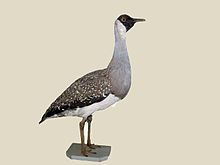Heuglin's bustard
| Heuglin's bustard | |
|---|---|

| |
| Male specimen at Nairobi National Museum | |
| Scientific classification | |
| Kingdom: | Animalia |
| Phylum: | Chordata |
| Class: | Aves |
| Order: | Otidiformes |
| Family: | Otididae |
| Genus: | Neotis |
| Species: | N. heuglinii
|
| Binomial name | |
| Neotis heuglinii (Hartlaub, 1859)
| |
Heuglin's bustard (Neotis heuglinii) is a species of bird in the bustard family.
Description[]
It is a fairly large species, at up to 89 cm (35 in) in length.[2] The males weigh 4–8 kg (8.8–17.6 lb) and the much smaller females weigh 2.6–3 kg (5.7–6.6 lb).[3] Other than size, sexes differ considerably in appearance. The striking male has a large back marking over the crown down the face to the chin with a bluish-grey neck. On the male, a chestnut band on the lower chest which is separated from the white belly by a thin black band. The female is much more of a subdued brownish color overall, with no bold black markings and has a face lined with faint slate-gray markings. In flight, the species reveals a white primary wedge on the otherwise dark upperwing, a feature obscured when the species is standing.[2]
The Heuglin's bustard is found in Djibouti, Eritrea, Ethiopia, Kenya, and Somalia. It occurs in pairs or small groups in arid or semi-arid grasslands, even ranging into desert-edge.[2]
References[]
- ^ BirdLife International (2016). "Neotis heuglinii". IUCN Red List of Threatened Species. 2016: e.T22691920A93328934. doi:10.2305/IUCN.UK.2016-3.RLTS.T22691920A93328934.en. Retrieved 11 November 2021.
- ^ a b c Field Guide to the Birds of East Africa: Kenya, Tanzania, Uganda, Rwanda, Burundi by Stevenson & Fanshawe. Elsevier Science (2001), ISBN 978-0856610790
- ^ CRC Handbook of Avian Body Masses by John B. Dunning Jr. (Editor). CRC Press (1992), ISBN 978-0-8493-4258-5.
- IUCN Red List least concern species
- Neotis
- Birds of the Horn of Africa
- Birds described in 1859
- Bird stubs
